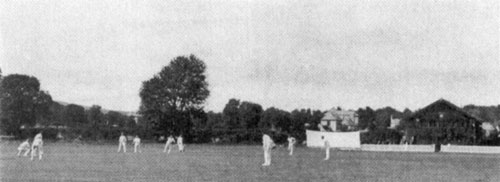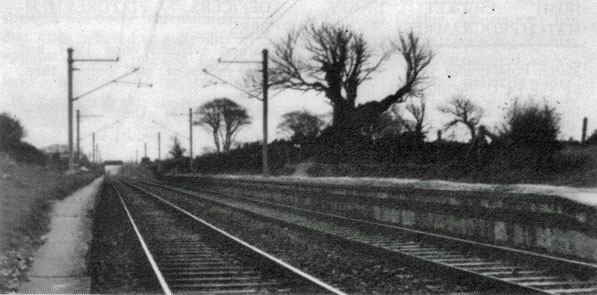One of those small, but endlessly fascinating byways of England-Australia history that never seems to have seen the light of day is the story of how Ireland nearly staged a Test match. What a strange thing it would have been had England played a 'home' Test with the players having to leave their shores and journey more than 100 miles across the Irish Sea! Cricket has thrown up a myriad of curiosities, and while such a circumstance may yet present itself one day in the future, for the present it must remain a happening unfulfilled.
It was in 1912 that the possibility arose. In that year of the Triangular Tournament, rain had ruined the first two Tests between England and Australia, both finishing as unsatisfactory draws. The third and final Test was due to start at The Oval on August 19. This match has often been referred to as the first 'timeless' Test in England, but this is only correct in so far as it began as a 'timeless' Test when the players first took the field, but before the close of the first day's play it had been officially transformed into a six-day match. It was not to be played to a finish if a win had not resulted after six days. The match began on a Monday and the six days were due to be played consecutively, without a rest. There was no question of the match going over the following week-end: Saturday was the final scheduled day in any event.
Decider
The removal of the 'timeless' element from the match had, of course, the important effect of inviting the possibility of a further draw. This final Test was to decide the winner of the Triangular Tournament, and so a draw had to be legislated against. The Board of Control, whose members were gathered at The Oval for the first day's play on August 19, held a formal meeting there at 4 o'clock that afternoon, with Lord Harris in the chair. It was at that meeting that the Board, somewhat late in the day, confirmed that the tournament would be decided on the 'rubber' system and also officially ordained the match to be of six days — and accordingly had to apply their minds to the possibility of a draw. (It should be stated that first-class cricket that August had suffered abysmally from the weather, so with even six days available a draw could not be ruled out).
It was publicly announced that evening that should the Oval game be drawn, another Test would be played (with the approval of the Australians). But the drama behind the scenes went unannounced. When the Board had come to consider the dates and venue for a possible further Test, they found it could really only be at The Oval on September 12 and the following days. The Australian tour itinerary, however, showed that on September 12, 13 and 14 they were already scheduled to play a three-day match at Woodbrook, Bray, in Co. Wicklow, on the grounds of SH (later Sir Stanley) Cochrane. The Board was in a dilemma. They were unable to announce either the date or place of a possible fourth Test without giving offence to Mr Cochrane, and all they could decide was that any further necessary Test would start at The Oval on September 12 subject to Mr Cochrane's consent.
 The ground at Woodbrook
The ground at Woodbrook
Fanatic
Stanley Cochrane, of course, was a fanatical lover of cricket who, at the start of the 1907 season, when he was still only 29, opened his splendid ground at Bray, running his own team, Woodbrook Club and Ground, and entertaining touring sides and county sides in cricket of high calibre. He could play himself, and in the very summer of 1912 (the year he became High Sheriff of Co. Dublin) scored 99 for Woodbrook v. Clontarf, sharing a stand of 213 for the first wicket with Albert Baker, of Surrey. He was a son of Sir Henry Cochrane, Bt, managing director of Cantrell and Cochrane, the Irish mineral water manufacturers; and a brother of the dramatist Ernest Cecil. But for Stanley Herbert Cochrane, while on his estate at Bray, thoughts in those high pre-First War summers were very much on cricket. The South Africans of 1912 had just enjoyed a week's cricket on his ground, and he was looking forward to the Australians.
In view of the clash of dates, Cochrane had been sent a telegram, asking: 'Would you kindly waive your prior claims?' Cochrane's reply came back: 'Will give up date if you play match here, every facility, and would do a lot of good for cricket in Ireland. — Cochrane.'
The Board of Control adjourned their meeting until the following afternoon, the second day of the Oval Test, when they met again at 4 p.m. They had had a night to sleep on the dilemma. This time they firmly decided it would be impossible to play the fourth Test in Ireland. But this time, too, a further telegram from Cochrane was read: 'Put my proposal before Board of Control — Cochrane.' Cochrane was immediately cabled that the match could not be played out of England and that if the Oval Test remained unfinished on Saturday, the Board of Control would be most grateful if Cochrane would consent to their request.
 The old Woodbrook pavilion<
The old Woodbrook pavilion<
Academic
On August 21, while the Oval Test was still in progress, the secretary of MCC received a telegram from Cochrane, thus: 'Will give way.' The matter became academic when England won at The Oval in four days, but it is intriguing to observe that had the game not finished in four days, then rain in London — indeed, over most of England — would have prevented play on the fifth and sixth days! Mr Cochrane would then have lost his visit from the Australians.
There is no doubt that a Test match in Ireland — and an England-Australia Test match at that — would have put the final seal of excellence, as well as the seal of immortality, on Stanley Cochrane's ground at Bray. It would have been, through circumstances entirely fortuitous, the miraculous culmination of all his cricketing ambitions. Cochrane was quick to realise the extraordinary situation before him — a prize beyond compare almost within his grasp. He might well have trembled at his sudden fortune. It was certainly worth making the representations he made. That it was not to be was probably the right and proper result: but in August, 1912, it could only have been a disappointment to Cochrane at a time when his cricketing activities were attracting some unfavourable local comment in Ireland.
Magnificent
Stanley Cochrane's cricket ground had everything lavished on it that a comfortable devotee could wish. It was a magnificent ground, laid out by H. Shelton, the Phoenix professional, who became groundsman there, and even had its own private railway station at Woodbrook (a distinction, among cricket clubs, shared only with the Germantown CC, of Philadelphia, in its heyday). The enormous hall that Stanley Cochrane had built for cricket was, in winter time, turned into a concert hall, and he would regularly bring over, at great personal expense, the London Symphony Orchestra for concerts of high quality. In fact cricket faded into the background gradually as Cochrane became more and more interested in music.
 All that remains of Sir Stanley Cochrane's private railway station at Woodbrook
All that remains of Sir Stanley Cochrane's private railway station at Woodbrook
Stanley Cochrane closed his cricket ground in 1913, and when the war came the following year he joined the Dublin Fusiliers (taking, incidentally, his valet- chauffeur and a Rolls-Royce with him!). In 1915 he received a baronetcy for services to cricket and music. After the war, both these activities gave way to golf, and the cricket ground is now part of a first-class golf course, where international and major golf tournaments are regularly staged.
Sir Stanley Cochrane died in 1949. Although only 35 of his 72 years had passed when he ended cricket at his Woodbrook home, he created an important niche for himself in the history of the game in Ireland. He created also an unusual entry in the memorabilia of the game, hitherto unknown to the avid students of England-Australia cricket lore.
